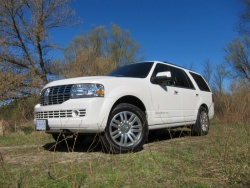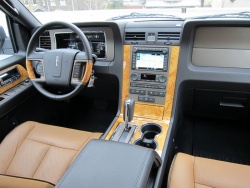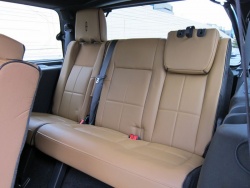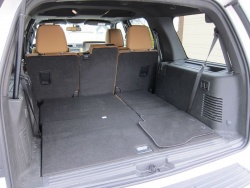Lincoln Navigator (left) and Cadillac Escalade. Click image to enlarge |
|
More Lincoln Navigator reviews at Autos.ca
Manufacturer’s web sites |
Article and photos by Peter Bleakney
Photo Gallery:
Luxury Heavyweights
Rising fuel prices and a general greening of our collective consciousness has made the mega luxury SUV a kind of vehiculum non grata — it is hardly the aspirational ride it once was. Yet for those who need to haul people, stuff, tow a big boat, and want do so in sybaritic splendour, these brutes are the way to go.
The Lincoln Navigator and Cadillac Escalade have a longstanding rivalry and are the top American dogs in this category.
So fuel economy be damned! As a service to our readers, we have spent altogether too much time at the gas pumps and braved the slings and arrows of the finger-wagging socially conscientious in order to ride these titans to a meaningful conclusion.
You’re welcome.
2012 Lincoln Navigator Limited 4×4
Lincoln is currently in the proccess of sprucing up its image, making a big push towards reestablishing the brand’s mojo and losing its longstanding rep as a maker of gussied-up-Fords-for-old-folks.
 Lincoln Navigator. Click image to enlarge |
After a week behind the wheel of a 2012 Navigator, I’m pretty certain this rig is not part of Lincoln’s new forward vision. This SUV saw its last refresh in 2007, but you’d be forgiven for thinking it was 1987 by the interior. I have nothing against nostalgia, but if blocky retro 80s dashes are cool again, I didn’t get the memo. And don’t get me started on the wood.
The Navigator rides on 20-inch wheels and cuts a conserative yet elegant profile. The only option on this tester was the lovely White Platinum Metallic Tri-coat paint ($500). Senior Editor Yarkony had this to say about its snout: “Did the Navigator’s grille get shinier? It’s not helping…”
Lincoln is letting the body-on-frame Navi live out its golden years unencumbered by many of the modern features and safety tech you’d expect in a luxury vehicle listing at $73,500 — like proximity key and push-button start, adaptive cruise control, and blind spot detection. Okay, it has little convex inserts in the side mirrors. The fact that the steering wheel only tilts and doesn’t telescope is a bit of a shocker, but the pedals are power adjustable.
   Lincoln Navigator. Click image to enlarge |
Power comes from Ford’s venerable three-valve 5.4L V8 making 310 horsepower and 365 lb-ft of torque. This is a proven engine, although dated, underpowered when looking at the competition and not particularly efficient. You won’t find this bent-eight anymore in the Ford F-150 pickup, but it soldiers on here.
Mated to a six-speed auto, the 5.4L makes for smooth progress and a lusty exhaust note. Official fuel mileage is 16.4 L/100 km city and 11.4 L/100 km highway. I averaged 17 L/100 km for the week. The Navi also gets hit with a $2,000 Green Levy gas-guzzler tax.
Speaking of smooth, this SUV glides down the road in the finest of Lincoln traditions. It’s like a big comfy couch. The standard heated and ventilated front seats are trimmed in buttery leather and coddle your backside over the long haul. The ride is cushy, the interior quiet and the standard THX audio sounds very good.
I’m happy to report the Navigator comes with standard navigation. How could it not?
It’s a bright and airy cabin, with a low belt line and good sightlines. Despite its girth, the Navigator is reasonably easy to manoeuvre thanks to standard backup camera and a tight turning circle.
You certainly couldn’t call the Navigator a sharp handler — it lazily floats along, discouraging abrupt inputs or enthusiastic cornering. But neither does it wallow excessively or list like a torpedoed freighter. Most will be buying the Navi for its utility, and here it shines.
With standard self-levelling suspension and heavy-duty tow package, this ute will pull up to 3,946 kg, although online reports say the V8 works hard for its keep. This tester was fitted with a no-charge three-seat 60/40 split rear bench that makes it an eight passenger vehicle in a pinch. Both the second and third row chairs recline, and access to the the back is reasonably painless. The power folding third row and easily dropped manual second row opened up a huge, flat cargo area.
The 2012 Navigator is all about utility and passenger comfort, but how comfortable will it be facing its archrival, the Cadillac Escalade?
2012 Cadillac Escalade Hybrid
In a perfect world, we’d have the 403-hp, 417 lb-ft, 6.2L V8, $80,210 base Escalade for this test, but press fleets being what they are, we get the 332-hp, 367 lb-ft, 6.0L V8 Hybrid with a starting price of, ouch, $95,110.
Cadillac Escalade. Click image to enlarge |
There’s no question the ‘Sclade’s celebrity status eclipses that of the Navi’s. This big black brute riding on 22-inch chrome wheels looked like it just rolled off the set of a music video.
We brought along our friend and mega SUV appreciator, Fab (no, that’s not a fake name, her name really is Fab), to help with our assessments. In her words, “The Escalade won hands down on the exterior design. Very, very sexy!”
Her reaction to the interior was a different story. “The interior of both cars were very lacklustre. The Escalade didn’t give me the impression I was driving a machine that fetched a $100K price tag. I want to enter a car and get my hair blown back by luxury. It was more like entering a cheap Asian import. QQ.” (Translation: QQ = tears, what the cool kids use instead of :(, apparently)
 Cadillac Escalade. Click image to enlarge |
After driving the Escalade, I started to appreciate the Navi’s cabin a bit more. Yes, the Caddy is more modern, but it feels dark and claustrophobic, where the Lincoln is airy and unapologetically retro in a (dare I say it?) charming sorta’ way. Yarkony weighed in (heavily) on this matter:
“The switchgear and fit and finish in the Escalade were incredibly disappointing… it wouldn’t be out of place in the Cruze, but for an iconic $100K flagship truck, it just doesn’t impress. And how can a truck so big have so little second row legroom? I know it’s apples to grapes, but even the Mazda5 does better than the Escalade, not to mention the second row seats don’t recline — how will your ‘entourage’ ever be cool if they can’t recline the second row seats? Oh well, I guess if the windows are tinted dark enough, no one will know anyway, but still, the indignity of upright seats…”
Another observation: the Navi’s power-retracting running board is standard issue, whereas Caddy asks $1,425 for the same convenience — naw, let’s call it a necessity.
But we have yet to address the elephant in the room. That would be the ‘Sclade’s massive chrome and green hybrid badge on its flanks and the $15 grand that buys you its associated hardware (plus some extra standard features).
  Cadillac Escalade. Click image to enlarge |
The two-mode hybrid system powering the Escalade was developed in conjunction with Chrysler, BMW, and, to a small extent, Mercedes-Benz. Developing hybrid propulsion for big utes was probably a good idea at the time, but now this highly complex transmission with its integrated electric motors is found only in the Escalade, Yukon Hybrid, and BMW X6 Active Hybrid (though this last not for much longer) — vehicles that sell in miniscule numbers.
In mode one, the Caddy runs like most full hybrids, operating on battery power, engine power, or a combination of both. Mode two is designed for towing, where under higher loads the V8 does most of the work and the transmission locks into its four planetary gears, largely bypassing the electric motors. It will tow up to 2,630 kg.
Helping out in the gas-saving department is Active Fuel Management, wherein half the cylinders go on vacation when cruising under light loads. The batteries occasionally kick in to take up the slack, keeping the Escalade in “V4” mode for longer periods.
And of course like all hybrids, the engine shuts off in stop-and-go driving. Official fuel consumption numbers are 10.4 L/100 km city and 8.5 L/100 km highway. We saw 13.8 L/100 km.
This Caddy certainly has more get-up-and-go than the Lincoln, although as with many hybrids, the driving experience is uneven. Occasional hesitancy and non-linear braking aside, it feels like a sports car compared to its crosstown rival. The steering is nicely weighted and the magnetic dampers do a decent job of keeping body motions in check. On a particularly twisty back road, the ‘Sclade’s power and poise made the Navi look like an geriatric Ford truck… oh, wait a sec…
The Verdict
 Lincoln Navigator (left) and Cadillac Escalade. Click image to enlarge |
So what are we left with here? If you want the blingy Escalade, get the regular 403-hp model. You’ll save a whack of dough and have more fun behind the wheel. The Navigator wins for comfort and utility although its engine is weaker and the package is dated.
My choice? Between these two I’d have to pick the Navigator for its useful interior layout, passenger comfort and value. The Escalade Hybrid is a technologically fascinating rig but the staggering price tag puts it out of contention.
And we’re not the only ones who think this. In 2011, GM Canada moved 1.092 6.2L gas Escalades versus only 94 Hybrids. Lincoln sold 609 Navigators in 2011.
Faced with buying this type of vehicle, I would go to my Inifiniti store and plunk down the $81,350 for the comprehensively equipped QX56 ($73,200 plus the $8,150 Technology package). The interior is gorgeous, the 400-hp V8 silken, and it drives better than either American. The QX56 is a modern take on the full-sized body-on-frame luxo-SUV, and yes, it looks, feels and goes down the road like the $80-grand vehicle that it is.
And we certainly can’t leave out the redesigned 2012 Dodge Durango. With a starting price of $47,295, the 360 hp AWD 5.7L Hemi R/T is a steal when compared to the Caddy, Lincoln and Infiniti. It may not have the cachet, but you can load it up with all the goodies and stil not break 60 grand. And tow up to 3,266 kg.
Hmmmm. Do we feel another comparo coming on?











